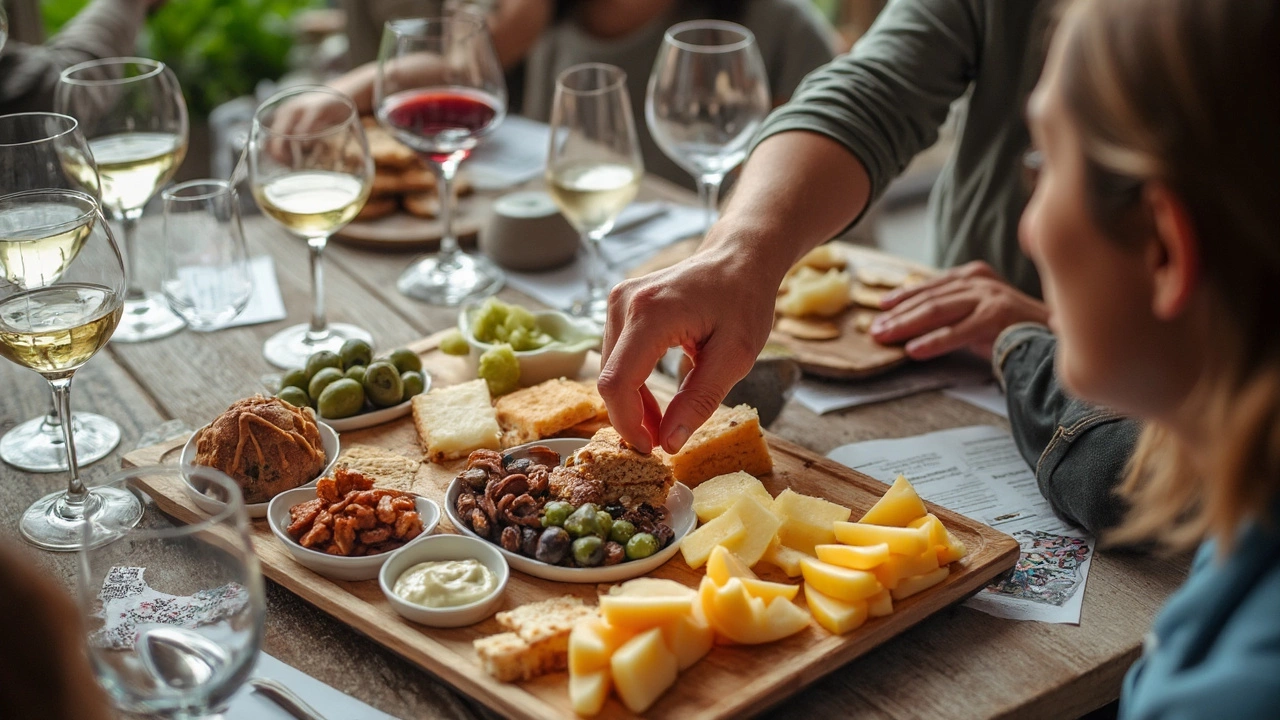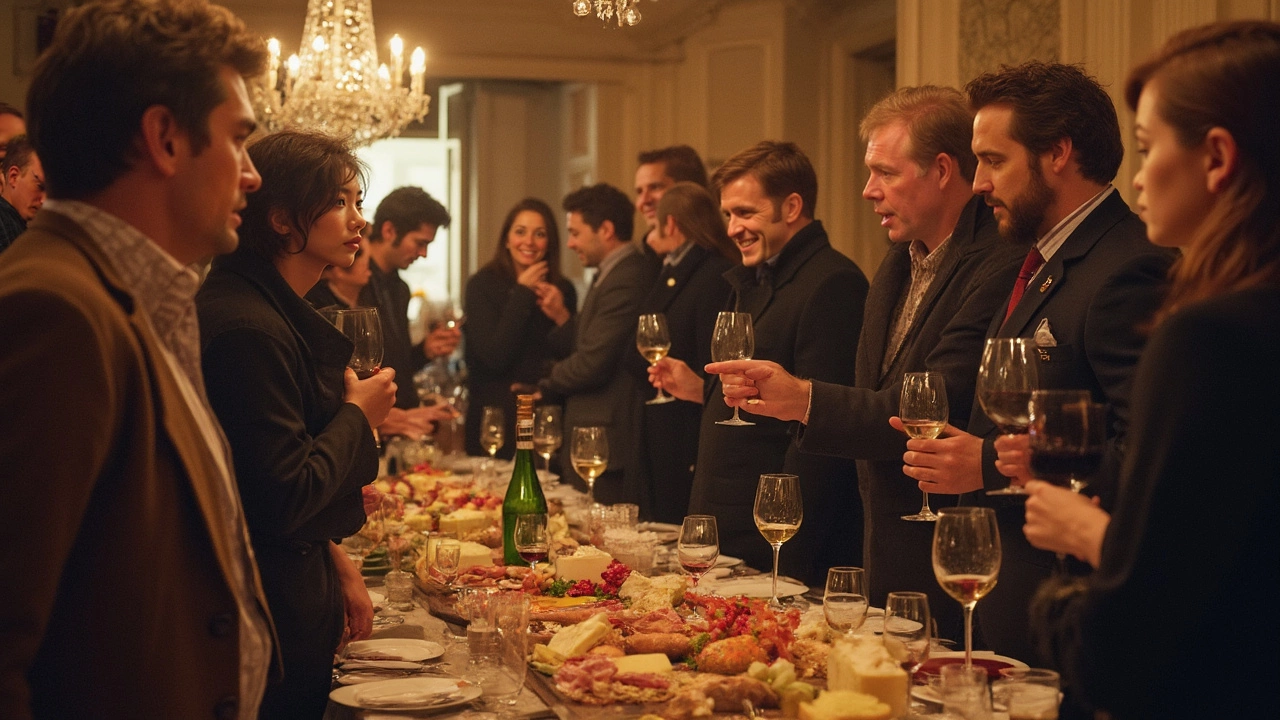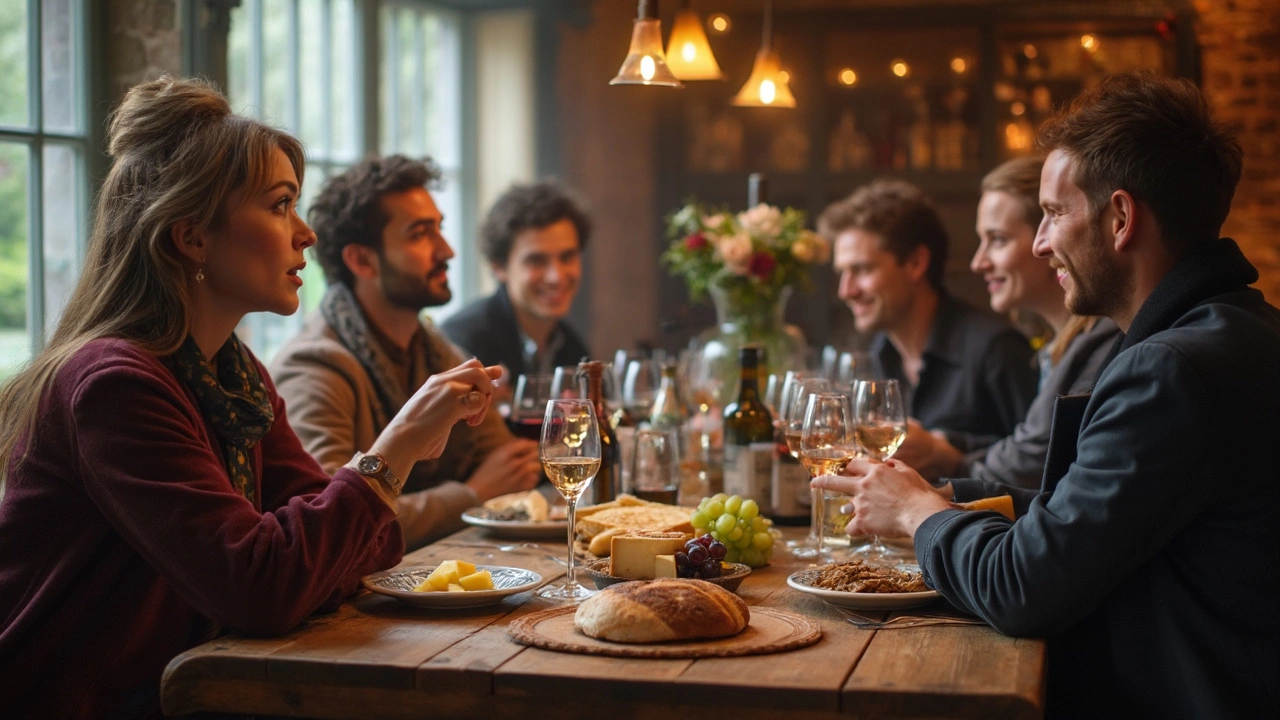You show up at a wine tasting and spot a table stacked with crackers and cheese. Is it okay to dig in, or will that make you look clueless? Seriously, tons of people wonder about this and the answer might surprise you. In most tasting rooms—whether it's a fancy winery in Napa or a low-key urban spot—nobody expects you to taste wine on an empty stomach. That’s good news, right?
Eating during a wine tasting isn’t just allowed, it can make the whole thing way better. But not all snacks are created equal. Some foods actually help you taste the wine more clearly, while others can totally mess with your palate. Basically, the trick is knowing what to eat, when to eat, and what to avoid if you want to enjoy every sip.
If you’ve ever felt lost about grabbing a bite while swirling your glass, you’re definitely not alone. In the sections ahead, we’ll break down what works best, the science behind pairing snacks with your wine, and the little etiquette tips that’ll keep you from looking like a rookie.
- The Unspoken Rules Around Eating at Wine Tastings
- How Food Changes the Way You Taste Wine
- Snacks That Pair Best (and Worst) with Wine
- Expert Tips for Balancing Bites and Sips
- Tasting Room Etiquette: Dos and Don’ts
The Unspoken Rules Around Eating at Wine Tastings
Ever walk into a wine tasting and feel like you’re supposed to know some secret food code? You’re not alone. Most tasting rooms do have a set of unwritten rules about eating, but once you know them, you won’t stress. The main thing is simple: food is there to help—not just to keep you from getting tipsy, but to balance and clear your palate. Here’s the rundown on what most hosts expect when it comes to snacking and sipping.
- Respect the order: If food is provided, wait until the host says it’s okay to nibble. Sometimes, tastings start with wine alone, then bring out snacks for certain pairings.
- Keep it clean: Don’t double dip or smear cheese everywhere. Places put out smaller plates and napkins so you don’t mess up shared trays for everyone else.
- Small bites only: The snacks are there to enhance, not to fill you up like a full meal. Grabbing handfuls of crackers won’t win you any points (and you don’t want to coat your taste buds with salt, anyway).
- Be mindful of strong flavors: Garlic knots, spicy pepperoni, and sticky barbecue sauces should be avoided. They overwhelm your palate and totally mess with the wine’s taste.
Some tastings are what’s called “guided” or “structured,” where the host will actually tell you what to try with each wine. Listen up here—it makes the whole experience smoother and more interesting, especially if you’re new to pairing wine and food.
| Snack | Purpose | Why It's Chosen |
|---|---|---|
| Plain Crackers | Palate Cleanser | Neutral flavor, doesn't compete with wine |
| Cubed Cheese | Softening Tannins | Adds creaminess, smooths bold reds |
| Nuts (unsalted) | Texture | Crunchy, won't overpower flavors |
| Green Apple Slices | Refreshing | Subtle acidity, refreshes mouth |
Here’s another tip: If you’re at a big event or festival, you might even spot people with necklaces covered in snacks (think pretzels or bagel chips). It looks goofy but serves a purpose—cleansing the palate on the go.
The point of these rules is to help you get the most out of each wine without distractions. Stick to them and you’ll not only enjoy the vibes, but actually taste what each producer is showing off.
If you want to sound like you know your stuff, use the phrase “palate cleanser”—it’s the official reason for every plain cracker on every tasting table. These little things matter in a proper wine tasting and honestly, nobody wants to be the person whose garlic breath ruins the pinot for everyone else.
How Food Changes the Way You Taste Wine
Ever noticed how cheese and crackers seem to make that glass of cabernet taste smoother? It’s not your imagination. What you snack on during a wine tasting directly impacts every sip. Here’s the real deal: food in your mouth changes the way your taste buds react to the wine that follows—or even the other way around. Sometimes, a salty bite makes wine taste less sharp. Tart or spicy foods can make the alcohol burn feel stronger. And anything sugary can throw off your taste for drier wines.
Let’s get specific. Scientists and sommeliers both agree that fat, salt, and protein—think cheese, charcuterie, nuts—tend to soften harsh tannins in red wines. Crunching on something salty like pretzels can turn a mouth-puckering wine into something that feels way smoother and easier to drink. That’s why most tasting rooms offer simple breadsticks, almonds, or mild cheeses.
But not all snacks are helpful. Artichokes, asparagus, or anything with loads of garlic can totally mess up your palate and make even amazing wine taste weirdly metallic or bitter. That’s why you won’t see those at a tasting table. If you want to experiment, here’s a quick cheat sheet on how basics foods usually affect different types of wine:
| Food Type | Common Effect on Wine |
|---|---|
| Cheese (mild) | Smoother mouthfeel, less astringency |
| Salty snacks | Lowers perceived acidity & bitterness |
| Sugar/desserts | Makes dry wine taste bitter or sour |
| Spicy foods | Boosts alcohol burn and heat |
| High-acid foods (citrus, tomatoes) | Can make wine seem less acidic—or, with low-acid wines, kinda flat |
If you want the most out of your tasting, keep food simple and neutral between different wines. Water and plain crackers work best for resetting your taste buds. Save the spicy stuff, chocolate, or heavy sauces for another time. Wine pros call this “cleansing your palate”—it keeps things fair between each pour so you can actually taste what makes each wine unique.

Snacks That Pair Best (and Worst) with Wine
If you want to actually enjoy the flavors in your glass, picking the right snacks is a big deal. There’s a reason cheese boards are everywhere at wine tastings. Plain cheeses, especially something mild like Swiss or Gouda, work wonders. They smooth out a wine’s sharp edges and don’t overpower what’s happening in your mouth. Even simple crackers are smart—they clear your palate and don’t leave strong flavors behind.
Fresh bread is another classic. It’s bland enough not to mess with wine, but filling enough so you don’t feel buzzed after two sips. You’ll also find nuts, especially almonds, at many tasting rooms. Unsalted nuts are best because salt can hype up the taste of alcohol or make a wine taste metallic if you’re not careful.
If you’re tasting bold reds, dried meats like prosciutto or mild salami can be a game-changer. They bring out savory notes in the wine (plus they’re just tasty). For whites or sparkling wines, green apples are awesome because they match the tartness and help you pick out fruity flavors in the wine.
- Best snacks: mild cheeses, plain crackers, fresh bread, unsalted nuts, green apples, and cured meats for reds.
But here’s where people trip up—the wrong snacks can actually wreck your tasting experience. Avoid spicy foods and anything heavily flavored, like barbecue chips or garlic bread. Strong flavors stick around, zapping your taste buds and making it tough to focus on what’s really in your glass. Chocolate is also a no-go unless the tasting specifically calls for it; it’s usually too sweet and clashes with most wines (except for very sweet dessert wines).
- Worst snacks: spicy foods, pickles, onions, garlic-heavy anything, chocolate (unless it’s a dessert wine pairing), and salty chips.
The goal is to pick foods that keep your palate clear so every pour gets a fair shot. You want to actually taste what the winemaker did—not what you had for lunch. And if you only remember one thing from this section, just know that simple, mild snacks are the best friends your wine tasting can have.
Expert Tips for Balancing Bites and Sips
There’s a real trick to making the most out of eating and drinking at a wine tasting. You’re not just piling cheese on crackers and hoping for the best. There are some key moves that can take your tasting game from newbie to pro, without overthinking it.
First up, always go easy on the palate. Big flavors (think garlic, onion, super strong cheese) can totally take over your mouth and mess with the way wine tastes. Stick to neutral snacks between pours. Crackers, plain bread, and water are your best friends here. This gives your mouth a reset so you catch more of the wine’s actual flavor.
Pace yourself. Don’t finish your snack stash before you’re halfway through the flight. Take a small sip, then a small bite, then another sip of the wine—that’s what pros call “re-tasting.” It helps you notice how food can change a wine’s flavor, texture, and even its smell. You’ll pick up on subtleties you might miss if you only taste each on their own.
When taking notes (and yes, that helps—phones work for this too), jot down what happens when you combine snacks with each wine. Find out, for example, if that goat cheese softens a sharp Sauvignon Blanc, or if salty nuts boost the fruit in a bold red.
- Go light on salty or spicy snacks; they can make the wine taste very different from what the winemaker planned.
- Have some water handy and rinse your mouth between different types of wine or especially strong foods.
- If there’s a food pairing planned by the host, taste it after an initial sip of wine, not before, so you get both the original and paired experience.
- Avoid using gum, mints, or scented hand sanitizers—they leave residual flavors that last longer than you’d think.
One last thing: nobody’s judging if you eat or skip the snacks. The main goal is to enjoy the wine, learn a little, and maybe find a new combo you actually want to try at home.

Tasting Room Etiquette: Dos and Don’ts
Let’s be honest, nobody wants to look out of place at a wine tasting. There are a few unspoken rules that regulars always follow, and breaking them can make things awkward fast. Here’s what you really need to remember if you want to leave a good impression and actually enjoy your experience.
- Wine tasting isn’t a drinking contest. Sip your wine, don’t gulp. You’re there to enjoy the flavors, not to pound drinks.
- Use the provided spittoon if you don’t want to swallow every pour. It’s normal, and even pros do it. Don’t feel weird or embarrassed—your neighbors are probably doing the same.
- Hold your glass by the stem, not the bowl. Warming the wine with your hand can mess with the aromas and taste.
- It’s totally cool to eat the snacks that are out, especially if you’re splitting tastings between reds and whites. Just avoid bringing outside food—most places are not fans of this unless you ask first.
- Go easy on strong-smelling snacks or perfumes. Garlic bread and super fragrant lotions can throw off the whole room’s tasting.
- Ask questions if you’re curious. Staff usually love sharing more about the wines or food pairings, and you’ll probably learn something unexpected.
If you want a quick run-down, here’s what behavior looks like in most tasting settings. Following these steps will keep things smooth and friendly:
- Greet your host and others at the bar.
- Listen for any instructions before you start sampling.
- Sip slowly, and use the spittoon if you want to pace yourself.
- Pair your bites between wines—not in the middle of tasting a single wine—unless you’re specifically told it’s a food-and-wine pairing flight.
- Thank your host on the way out, even if you don’t buy a bottle.
Just to clear things up, here’s a quick table breaking down moves that work and moves that flop in most tasting rooms:
| Do | Don’t |
|---|---|
| Hold glass by the stem | Grab glass by the bowl |
| Try provided snacks | Bring your own food without asking |
| Ask questions about wine | Drown out the host or talk over others |
| Use the spittoon | Chug every sample |
| Thank the staff | Leave without a word |
Following these basics makes you look like you belong, whether it’s your first or fiftieth time. Nobody expects perfection, but a little respect for the vibe goes a long way in any tasting room.

